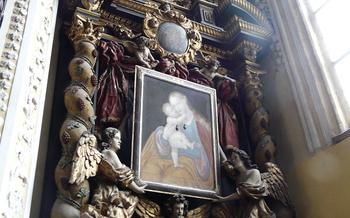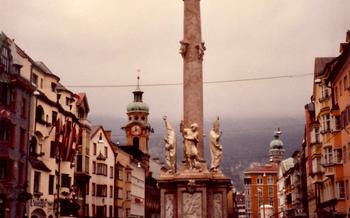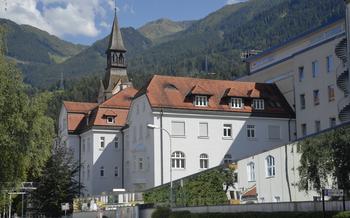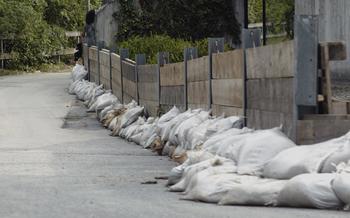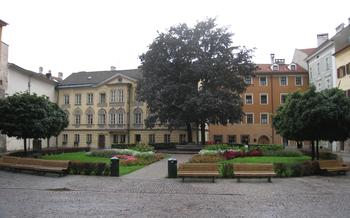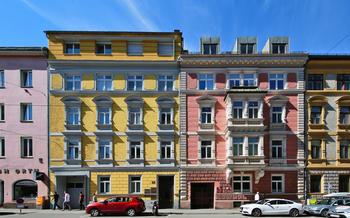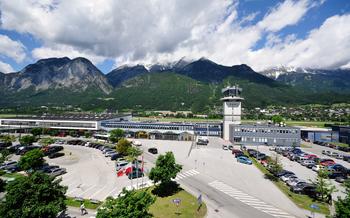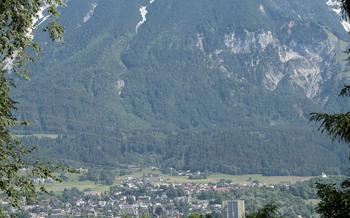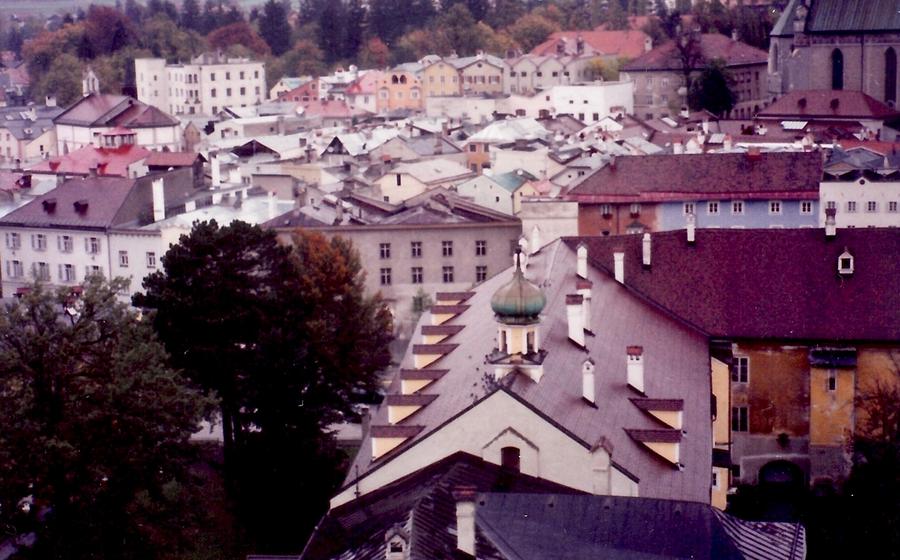
Hofgarten Innsbruck
- Hofgarten Innsbruck: A Majestic Green Oasis in the Heart of the City
- Exploring the Royal Heritage: Tracing the Footsteps of Emperors
- A Haven for Art and Culture: Sculptures and Monuments
- The Hofburg Palace: A Majestic Neighbor
- The Innsbruck Cathedral: A Spiritual Landmark
- The Golden Roof: A Symbol of Imperial Splendor
- The Hofkirche: A Majestic Tribute to Emperor Maximilian I
- The Tyrolean State Museum: A Journey Through History and Culture
- The Alpine Zoo: A Unique Encounter with Mountain Wildlife
- Nordkette Mountains: A Majestic Alpine Panorama
- Swarovski Crystal Worlds: A Realm of Sparkling Wonder
- The Bergisel Ski Jump: Soaring High Above Innsbruck
- The Old Town of Innsbruck: A Journey Through History
- The Christmas Market: A Festive Spectacle
- Insider Tip: Hidden Gems of the Hofgarten
Hofgarten Innsbruck: A Majestic Green Oasis in the Heart of the City
Nestled in the heart of Innsbruck, the Hofgarten is a stunning Renaissance-style garden that invites visitors to immerse themselves in its serene beauty. With a history dating back to the 16th century, the garden was commissioned by Archduke Ferdinand II as a private retreat and later became a public park in the 18th century. Stroll through its meticulously manicured lawns, admire the vibrant flowerbeds, and seek shade beneath towering trees as you explore this tranquil oasis. The Hofgarten's captivating charm is enhanced by its elegant architectural features, including stunning Renaissance-style arcades adorned with intricate carvings and decorative fountains that add a touch of grandeur to the surroundings. Whether you seek a peaceful respite from the bustling city or an opportunity to embrace the beauty of nature, the Hofgarten offers a serene sanctuary in the heart of Innsbruck.
Exploring the Royal Heritage: Tracing the Footsteps of Emperors
The Hofgarten Innsbruck holds a deep connection to the Habsburg dynasty, serving as a cherished retreat for royalty throughout history. Emperors and empresses sought solace and tranquility within its serene landscapes, leaving behind a legacy of imperial grandeur.
One captivating anecdote recounts the story of Emperor Maximilian I, who was particularly fond of the Hofgarten. He commissioned the construction of a Giant's Staircase, a monumental staircase adorned with intricate carvings, to provide direct access from the Hofburg Palace to the garden. This grand staircase remains an iconic symbol of the emperor's love for his private sanctuary.
Another notable feature is the Sun Terrace, a secluded spot within the garden reserved exclusively for the imperial family. Here, royalty could bask in the warmth of the Tyrolean sun, sheltered from the public gaze. Visitors can still admire the remnants of this imperial retreat, transporting them back to an era of opulence and privilege.
To delve deeper into the royal history of the Hofgarten, guided tours or self-guided walks are highly recommended. These tours offer fascinating insights into the lives of the emperors and empresses who graced the garden, bringing the past to life and allowing visitors to experience the Hofgarten through the eyes of royalty.
A Haven for Art and Culture: Sculptures and Monuments
The Hofgarten is not only a green oasis but also a haven for art and culture. Visitors can admire an impressive collection of sculptures and monuments that adorn the garden, each with its own unique story to tell. From the majestic bronze statue of Archduke Leopold V, the founder of the Hofgarten, to the intricate stone carvings that depict scenes from Greek mythology, the garden is a veritable outdoor museum.
One of the most notable sculptures in the Hofgarten is the Giant's Staircase, a monumental fountain adorned with statues of mythical creatures and allegorical figures. The staircase was designed by Hans Multscher, a prominent artist of the late Gothic period, and is a masterpiece of Renaissance art.
Another highlight of the garden is the Sun Terrace, a beautiful loggia decorated with frescoes and statues. The terrace offers stunning views of the surrounding mountains and is a popular spot for visitors to relax and soak up the sun.
To fully appreciate the art and history of the Hofgarten, visitors can take a guided tour or explore the garden on their own using a map or guidebook. The garden is a treasure trove of hidden gems, and visitors are sure to discover something new and fascinating with each visit.
The Hofburg Palace: A Majestic Neighbor
Standing adjacent to the Hofgarten, the Hofburg Palace is a magnificent architectural masterpiece that embodies the grandeur of the Habsburg dynasty. A former imperial residence, the palace has witnessed centuries of history and played a crucial role in shaping the region's destiny.
Explore the opulent imperial apartments, adorned with intricate tapestries, gleaming chandeliers, and priceless works of art, offering a glimpse into the lavish lifestyle of the Habsburg royals. Immerse yourself in the grandeur of the state rooms, where emperors and empresses once held court and made decisions that shaped the course of history.
Don't miss the opportunity to visit the Silver Chapel, a stunning example of Baroque architecture, with its intricate silver altar and exquisite ceiling frescoes. Stroll through the palace gardens, a tranquil oasis adorned with manicured lawns, colorful flowerbeds, and towering trees, providing a serene escape from the bustling city.
Enhance your experience by joining a guided tour or embarking on a self-guided walk to uncover the fascinating stories and secrets hidden within the palace walls. Discover the legacy of the Habsburgs and their enduring impact on Innsbruck and the surrounding region.
The Innsbruck Cathedral: A Spiritual Landmark
The Innsbruck Cathedral, also known as the Cathedral of St. James, stands as a magnificent testament to Gothic architecture and spiritual devotion in the heart of Innsbruck. Its striking exterior, adorned with intricate carvings and graceful spires, hints at the awe-inspiring beauty that awaits within. Step inside to marvel at the cathedral's soaring vaulted ceilings, delicate stained glass windows that bathe the interior in a kaleidoscope of colors, and the impressive high altar with its intricate carvings and gold leaf embellishments.
The cathedral holds immense historical and religious significance for the people of Innsbruck. It was built in the 12th century and has undergone several renovations and expansions over the centuries, reflecting the evolving architectural styles and the devotion of the local community. The cathedral served as the court church for the Habsburg dynasty, and many members of the imperial family are buried within its walls.
Beyond its architectural and historical significance, the Innsbruck Cathedral remains a vibrant spiritual center for the Catholic community. Regular masses, concerts, and special events are held throughout the year, attracting both locals and visitors who seek solace, inspiration, and a connection to their faith. Whether you're a history buff, an architecture enthusiast, or simply seeking a moment of tranquility, the Innsbruck Cathedral is a must-visit destination in the city.
The Golden Roof: A Symbol of Imperial Splendor
A Legacy of Imperial Grandeur:
The Golden Roof, or Goldenes Dachl, stands as a mesmerizing symbol of imperial splendor in the heart of Innsbruck. Constructed in the early 16th century under the reign of Emperor Maximilian I, this remarkable architectural masterpiece encapsulates the grandeur and opulence of the Habsburg dynasty.
A Masterpiece of Gothic Architecture:
The Golden Roof is a stunning example of late Gothic architecture, showcasing intricate carvings, elaborate decorations, and a shimmering golden roof that has made it an iconic landmark of Innsbruck. The roof features 2,657 fire-gilded copper tiles, painstakingly arranged to create a mesmerizing mosaic of imperial symbols, heraldic emblems, and intricate patterns.
A Glimpse into Imperial Life:
The Golden Roof served as a ceremonial balcony for the Habsburg emperors, who would appear before their subjects during special occasions and festivities. Imagine the grandeur of imperial processions and celebrations as the emperor and his entourage emerged from the opulent Hofburg Palace, greeting the cheering crowds below.
A Must-See Landmark:
Today, the Golden Roof remains one of Innsbruck's most cherished landmarks, attracting visitors from around the world. Its unique architectural style, historical significance, and symbolic representation of imperial power make it a must-see destination for anyone exploring the rich heritage of the city.
Practical Information:
To fully appreciate the Golden Roof's splendor, visitors can admire it from various vantage points. The best views can be obtained from the street below, where one can capture the full extent of its intricate details. Guided tours of the Hofburg Palace often include a visit to the Golden Roof, providing insights into its history and significance.
The Hofkirche: A Majestic Tribute to Emperor Maximilian I
In the heart of Innsbruck, nestled amidst the bustling streets and towering mountains, lies the Hofkirche, a Gothic masterpiece that serves as a majestic tribute to Emperor Maximilian I. Constructed between 1553 and 1563, this awe-inspiring church stands as a testament to the power and legacy of the Habsburg dynasty.
As you step through the grand entrance, prepare to be captivated by the intricate carvings, soaring arches, and stunning stained glass windows that adorn the interior. The church's most remarkable feature is the magnificent cenotaph of Emperor Maximilian I, an elaborate tomb adorned with 28 larger-than-life bronze statues of the emperor's ancestors, allies, and mythological figures. Each statue, crafted with exquisite detail, represents a chapter in the emperor's illustrious life and lineage.
In addition to the cenotaph, the Hofkirche houses a collection of impressive artwork, including paintings, sculptures, and tapestries. Don't miss the stunning stained glass windows depicting scenes from the life of Christ and the Virgin Mary, which bathe the interior in a kaleidoscope of colors.
The Hofkirche is not just a historical monument but also a spiritual sanctuary. Every Sunday, the church hosts traditional Catholic masses, inviting visitors to experience the sacred atmosphere and rich traditions of the local community.
Whether you're a history buff, art enthusiast, or simply seeking spiritual inspiration, the Hofkirche is a must-visit destination in Innsbruck. Its grandeur, beauty, and historical significance will leave an unforgettable impression on every visitor.
The Tyrolean State Museum: A Journey Through History and Culture
Nestled in the heart of Innsbruck, the Tyrolean State Museum is a treasure trove of artifacts that narrate the rich history and cultural heritage of the region. Its diverse collections span archaeology, art, natural history, and Tyrolean customs, offering visitors a comprehensive journey through the ages.
The museum's exhibits showcase the region's fascinating past, from prehistoric settlements to the grandeur of the Habsburg era. Visitors can trace the evolution of Tyrolean art through centuries-old paintings, sculptures, and intricate wood carvings. The natural history section delves into the region's diverse flora and fauna, highlighting the unique ecosystems of the Alps.
Interactive displays bring history to life, allowing visitors to engage with the exhibits in a hands-on manner. Children can embark on an educational adventure through the museum's dedicated discovery zone, designed to spark curiosity and foster a love for learning.
A visit to the Tyrolean State Museum is a must for anyone seeking to delve into the cultural tapestry of Tyrol. Its vast collections and engaging exhibits provide a comprehensive understanding of the region's heritage, ensuring an enriching and unforgettable experience.
The Alpine Zoo: A Unique Encounter with Mountain Wildlife
Nestled amidst the breathtaking Tyrolean Alps, the Alpine Zoo offers a unique opportunity to encounter the region's rich wildlife in their natural habitat. This specialized zoo is home to a diverse range of alpine animals, including ibex, marmots, bears, and birds of prey, all showcased in spacious and naturalistic enclosures that replicate their native environments.
Visitors to the Alpine Zoo can observe these majestic creatures up close and learn about their fascinating behaviors and adaptations. Interactive exhibits and educational displays provide insights into the zoo's conservation efforts and the importance of protecting these endangered species.
Families with children will particularly enjoy the interactive feeding sessions and educational programs offered by the zoo, allowing them to engage with the animals and gain a deeper understanding of the delicate balance of the alpine ecosystem.
Practical Information:
- Admission Fees: Adults: €15; Children (6-15 years): €8; Families (2 adults + 2 children): €35
- Visiting Hours: Daily from 9:00 AM to 5:00 PM (April to October)
- Special Events and Programs: Guided tours, animal encounters, and educational workshops are offered throughout the year. Check the zoo's website for details.
Nordkette Mountains: A Majestic Alpine Panorama
The Nordkette Mountains, a majestic chain of peaks that encircles Innsbruck, offer a breathtaking Alpine panorama that is sure to captivate any visitor. The mountains rise dramatically from the city, creating a stunning backdrop that can be admired from various vantage points. For those seeking an unforgettable experience, the Nordkette cable cars provide a convenient and scenic ascent to the mountain peaks, revealing awe-inspiring views of the surrounding landscape.
The Nordkette is a paradise for outdoor enthusiasts, with an extensive network of hiking trails that cater to all fitness levels. Whether you prefer leisurely strolls through alpine meadows or challenging climbs to the summits, the Nordkette offers an unforgettable hiking experience. Along the way, you'll encounter stunning viewpoints, crystal-clear mountain lakes, and the chance to spot local wildlife, including ibex, marmots, and golden eagles.
For those seeking a more thrilling adventure, the Nordkette is home to several via ferrata routes, which allow you to scale the mountain cliffs using fixed cables and ladders. These routes provide a unique and challenging way to experience the mountains while enjoying breathtaking views.
Whether you choose to hike, take the cable cars, or try your hand at via ferrata, the Nordkette Mountains offer an unforgettable Alpine experience that will leave you with lasting memories.
Swarovski Crystal Worlds: A Realm of Sparkling Wonder
Nestled in the picturesque village of Wattens, just a short drive from Innsbruck, lies a realm of shimmering enchantment - the Swarovski Crystal Worlds. This captivating museum invites visitors to step into a world where crystals take center stage, creating an unforgettable experience that blends art, innovation, and wonder.
From the moment you enter the museum, you'll be captivated by the dazzling array of crystal creations that adorn every corner. Interactive exhibits showcase the history, craftsmanship, and brilliance of Swarovski crystals, allowing you to delve into the fascinating world of crystal making.
One of the highlights of the museum is the Crystal Cloud, a mesmerizing installation composed of hundreds of thousands of crystals that shimmer and dance in the light. The Crystal Theatre, with its immersive multimedia presentations, takes you on a journey through the magical realm of crystals, revealing their hidden stories and symbolic meanings.
Throughout the museum, you'll encounter stunning crystal sculptures, chandeliers, and installations that defy imagination. Each piece is a testament to the artistry and precision that goes into creating these exquisite works of art.
Whether you're a crystal enthusiast, an art lover, or simply seeking a unique and unforgettable experience, the Swarovski Crystal Worlds is a must-visit destination. Prepare to be mesmerized as you immerse yourself in a realm where crystals come to life, sparking your imagination and leaving you with a lasting sense of wonder.
The Bergisel Ski Jump: Soaring High Above Innsbruck
The Bergisel Ski Jump stands as a testament to Innsbruck's rich sporting heritage and its passion for winter sports. This architectural marvel, designed by the renowned Iraqi-British architect Zaha Hadid, is a breathtaking sight, soaring high above the city. Visitors can take a thrilling ride to the top of the ski jump, where they will be rewarded with awe-inspiring panoramic views of Innsbruck and the surrounding Tyrolean Alps.
The Bergisel Ski Jump has played a pivotal role in hosting major international ski jumping competitions, including the Winter Olympics. Its iconic silhouette and cutting-edge design have made it a symbol of Innsbruck's sporting prowess and a must-visit attraction for visitors from around the world.
Practical Information:
- Admission Fees: Adults: €10; Children (6-15 years): €5; Families (2 adults + 2 children): €25
- Guided Tours: Guided tours are available upon request and provide insights into the history and architecture of the ski jump.
- Special Events: The Bergisel Ski Jump frequently hosts special events and competitions throughout the year, including the annual Four Hills Tournament. Check the official website for more information.
The Old Town of Innsbruck: A Journey Through History
Innsbruck's Old Town invites you on a captivating journey through time. Wander along its cobblestone streets, lined with charming buildings painted in pastel hues. Admire the intricate details of the Helblinghaus, a 16th-century merchant's house with its elaborate frescoes and oriel windows. The Golden Eagle Pharmacy, with its gilded eagle perched atop its sign, is a testament to the town's rich history. Ascend the Town Tower, a 14th-century landmark, for breathtaking panoramic views of the city and the surrounding mountains.
Lose yourself in the labyrinth of narrow alleys, where boutiques and shops beckon with local treasures and souvenirs. Savor the aromas of Tyrolean cuisine wafting from traditional restaurants, inviting you to indulge in culinary delights like Käsespätzle (Tyrolean cheese noodles) or Tiroler Gröstl (fried potatoes with meat and onions). Take your time to explore every nook and cranny, discovering hidden courtyards, historic fountains, and charming cafes tucked away from the main tourist routes. Innsbruck's Old Town is a living museum, where the past and present harmoniously blend, inviting you to immerse yourself in its timeless allure.
The Christmas Market: A Festive Spectacle
During the festive season, Innsbruck transforms into a winter wonderland, with the Christmas Market taking center stage. The scent of roasted chestnuts, gingerbread, and mulled wine fills the air as visitors wander through the charming wooden stalls adorned with twinkling lights and festive decorations. The market offers a delightful array of traditional Tyrolean crafts, from intricate wood carvings and hand-painted ornaments to warm woolen garments and sparkling crystal creations. Local delicacies like Kiachln (fried pastries) and Glühwein (mulled wine) provide a taste of Tyrolean culinary traditions. The market also features live performances, including traditional Tyrolean music and dance, adding to the festive atmosphere. Whether you're looking for unique gifts, delicious treats, or simply a magical winter experience, Innsbruck's Christmas Market is a must-visit.
Insider Tip: Hidden Gems of the Hofgarten
Beyond the manicured lawns and ornate fountains, the Hofgarten holds several hidden gems waiting to be discovered by curious visitors. One such treasure is a secret garden, tucked away from the main paths, offering a tranquil oasis for relaxation and contemplation. Surrounded by lush greenery, this secluded spot invites visitors to slow down, breathe deeply, and immerse themselves in the beauty of nature.
Another hidden gem is a historical monument that often goes unnoticed amidst the grandeur of the garden. This monument, with its intriguing history and symbolism, holds stories of the past that are waiting to be uncovered. Visitors who take the time to explore the garden's lesser-known corners will be rewarded with a deeper appreciation for its rich heritage.
For those seeking a unique perspective, the Hofgarten offers several spots that provide breathtaking views of the surrounding mountains and landmarks. Whether it's the panoramic vista from a hidden terrace or a secluded bench overlooking the city, these vantage points allow visitors to capture the essence of Innsbruck and its stunning Alpine surroundings.
Finally, no exploration of the Hofgarten would be complete without sampling the local culinary delights. Just a stone's throw from the garden, visitors can find charming cafés and traditional Tyrolean restaurants where they can indulge in mouthwatering specialties and refreshing beverages. These local favorites offer a taste of authentic Tyrolean cuisine and a chance to interact with the friendly locals who make Innsbruck such a welcoming destination.
